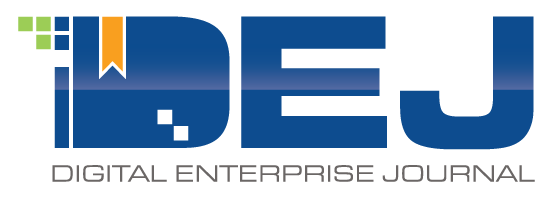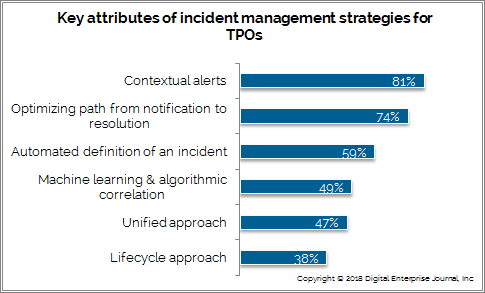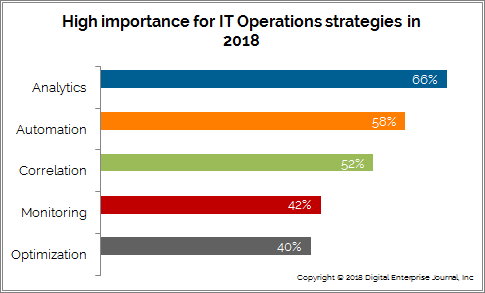DEJ’s research recent study “17 Key Areas Shaping the IT Operations Market in 2018” identified key market dynamics, adoption drivers, major user requirements and the general direction this market is headed. This article provides additional analysis of this research and highlights some of the key stories behind the study.
1 – Technologies are “crossing the chasm” faster – be ready to manage them
The study found that organizations are replacing their IT Operations management solutions at a rate that is 3.1 times faster as compared to 2013. This is mostly due to the fact that new technologies which need to be managed are entering the enterprise much faster and organizations are realizing that they need to be leveraging new capabilities to make sure that these technologies are delivering on their promise.
The path from ”Innovators” to “Early Adopters” to “Early Majority” is becoming significantly shorter every year and playing “catch up” or taking a “wait and see” approach in adopting and managing technologies could be a risky strategy. By the time organizations buy into a new technology approach, their competitors might be already mastering the problem they are trying to solve and moving on to the next technology approach that would give them a competitive advantage.
2 – Enabling customer centric IT is key
Organizations ranked making IT customer centric a #1 goal for IT transformation. . This requires not only changes in technologies that are being deployed, but also changes in a corporate culture and a new organizational alignment and structure of the processes. Mostly, it requires a mind shift. Building a customer-centric IT is becoming a key requirement for CIOs to get the seat at the boardroom table and organizations that are taking this approach are already seeing the benefits at the business level.
Enabling customer centric IT is a very complex process and it includes many fundamental changes and moving parts. However, avoiding or delaying it comes at a huge risk. As DEJ previously noted, digital transformation is the biggest impact that technology is having on business since CERN made Internet generally available in 1993. In order for the IT to stay relevant in that process, they need to be deploying the following core capabilities:
- Ability to measure IT performance at the point of user’s interaction with the application
- Advanced analytics for making better IT and business decisions based on user feedback
- Benchmarking performance against competitors and industry standards
3 – New IT service delivery organization and processes are needed
In order to best deal with increased complexity and customer expectations, as well as with the need for successfully deploying new technologies, organizations need to rethink their processes and the organizational structure of their IT departments. New IT service delivery organizations should consider four key pillars: 1) infrastructure; 2) development and services, 3) applications and 4) business. Additionally, organizations should build vertical monitoring groups while considering some concepts of IT Operations Transformations Principal job role responsibilities.
This way of structuring IT organization allows businesses to properly evaluate IT Operations tools, redefine the concept behind DevOps (that is mostly driven by Developers – 58% – per DEJ’s research) and truly align the value of IT to the business. This organizational approach would also enable IT Operations professionals to not only be more effective in managing new technology deployments, but also play an instrumental role in launching new digital transformation initiatives. More importantly, this type of approach would enable them to hit on all of their key goals of IT service delivery such as: 1) ensuring optimal user experience; 2) ability to support the business; 3) and agility and continuous delivery.
4- Understand and embrace the concept of digital transformation and carve up your role in the process
DEJ’s study shows that enabling digital transformation (DT) is one of the key growth opportunities for IT Operations management technologies. However, DT enablement will not tolerate some of the traditional attributes and outcomes of IT management solutions such as:
- Silo-based approach
- Lack of visibility into the business impact
- Lack of service level visibility
- Reactive approach
- Too many resources being allocated to “keeping the lights on” (managing and maintaining existing services)
- Manual processes for leveraging performance data to solve problems
Success in enabling digital transformation can allow IT Operations solutions to move higher on CIOs agendas and make their role more strategic. In order for that to happen, the value of these technologies should be centered around: 1) user experience; 2) business enablement; 3) supporting deployment and management of technologies that are transforming the enterprise. That requires a major shift from the traditional IT management practices and continuous innovation of IT Operations vendors’ product offerings.
5 – Make sure your IT Operations “data lake” is solid
The study shows that the value of automation and machine learning touches every key pain point that organizations are experiencing. However, organizations need to be aware that, in the majority of cases, the effectiveness of their IT automation, AIOps and machine learning solutions is defined by the quality of data that their monitoring tools (application, network, infrastructure, etc.) are generating.
When thinking about modernizing their IT operations, organizations need to be aware of their level of maturity and make sure that they don’t skip any critical steps. Jumping from having very little visibility into their infrastructure and applications straight into AI enabled technologies typically will not work. Building a solid data lake and having end-to-end visibility into their IT environments is one of the key prerequisites for taking their IT Operations strategies to the next level and being able to truly modernize IT Operations. In order to achieve that, organizations should consider the leading solutions in the key areas of building their IT Operations data lakes such as: 1) infrastructure and service monitoring; 2) applications
6 – Being the CMO of an IT Operations management vendor is difficult
Communicating the value of IT Operations solutions, given the dynamics of this market as reported in the study, is difficult for many reasons:
- Most of the solutions that are well positioned to enable modern IT Operations don’t really fit any traditional definitions of technology classes. Even though these solutions are built for current and emerging problems of this market and are already proving the value by addressing challenges of forward-thinking user organizations in a unique way, it is difficult for them to communicate their value by using traditional marketing approaches because they don’t really belong in pre-defined “technology buckets”.
- Buzz words like AI and ML will help in gaining attention from user organizations, but using them creates a whole new challenge. 62% of organizations in the study reported that it is difficult to identify differentiators between different AI or ML based solutions.
- Leading with the AIOps message creates additional challenges from the marketing perspective: 1) AIOps, currently defined, is a “mish mash” of underlining technologies that don’t compete against each other and are addressing different problems and use cases; 2) organizations are still not budgeting for AIOps solutions; 3) The AIOps message is being driven by a group of vendors that don’t have a marketing muscle to make this acronym something that end-users can be dedicated to and are willing to explore in depth.
In order to overcome these challenges, technology vendors will have to redefine their elevator pitch and marketing positioning to focus on business outcomes, not KPIs. This becomes a completely different type of sale and calls for new types of customer engagements. In the context where you, as a go-to-market leader, can’t piggyback on other vendors’ marketing messaging, IT Operations CMOs should focus on four key areas: 1) creating a business case for deployment as a part of their offerings; 2) CLEAR positioning around digital transformation enablement; 3) alignment with key technology transformation use cases; 4) proof points around key challenges addressed.
7 – Throwing more people towards IT problems is proven not to work
Seventy-nine percent of organizations are reporting that this is NOT an effective approach. New strategies for incident management are the best example of this. The study shows that providing context and deploying automation are major differentiators when it comes to improving metrics, such as increase in actionable tickets, user experience and operational cost.
Additionally, organizations are increasingly understanding that this is not just a productivity issue. This is a multipronged challenge that includes: 1) the ability to acquire and retain costly data science professionals; 2) finding a way to apply analytics and automation as a part of the broader IT Operations strategy; 3) measuring the overall impact on internal and internal customers (beyond just productivity metrics).
8 – It is automation, analytics and data management game
The study shows that there is very little correlation between the amount of data collected and performance improvements. Additionally, 61% of organizations reported an increase in plans for deploying non-monitoring capabilities for IT Operations in 2018. Lastly, the majority of capabilities that are making a difference between achievements of TPO organizations and the rest of the market are related to analytics, automation, correlation and data management. This opens up opportunities for vendors that are applying these types of capabilities to address some of the key pain points and use cases in this market.
9 – New selection and purchasing process
Modernizing IT Operations is a complex process and it requires a new approach for evaluating vendors. There is no clear leader in the market for modern IT Operations and there is not a single vendor that can address all the key needs for end-user organizations. The “one-size-fits-all” approach is not effective in this market, as the effectiveness of these solutions varies based on the use case, technologies under management, type of IT environment or major pain points. Therefore, organizations should apply situational analysis when evaluating these solutions and instead of trying to identify a market leader, build an internal process for evaluating technologies that will allow them to identify the solution that is the best fit for them.
10 – There is a lot of innovation in this space – keep an eye on emerging players
Twenty-seven percent of organizations in the study reported that they are considering purchasing solutions in 2018 that they were not aware of 12 months ago. A number of organizations are entering this market with innovative approaches and strategies that already allow them to replace some of the incumbents in this market. The study shows that 36% of purchases of IT Operations solutions in 2017 were green field opportunities that didn’t involve replacing existing vendors, but closing the performance gaps that other solutions are leaving and making the tools that organizations already had in place more effective.
When building their IT Operations strategies, organizations should keep in mind that technology innovation in this space has been accelerated. The timeframe that a technology provider goes through from bringing a different and innovative approach to the market to becoming a widely recognized market leader is becoming exponentially shorter every year (see examples of AppDynamics, Dynatrace and New Relic in the APM space – from 2012-2015). In order to catch up with this trend, when searching for solutions providers, organizations should be looking beyond industry acronyms that define technology classes and, instead, focus on a vendor’s ability to address their key operational and business challenges.
Summary
Building a successful IT Operations strategy in 2018 means going back to the drawing board and doing it often. In an age when technology is being used as a source of competitive advantage, IT Operations need to transform and modernize to be able not only to catch up, but perform at the level that would enable their business organizations to outperform their key competitors and market standards.
The old school approach of “no one lost their job because they bough Vendor X” is gone. Actually, taking that approach is exactly why you could lose your job. Technology deployments in digital economy are all about creating a competitive advantage. If your competitor is deploying capabilities and building strategies that are more advanced, it will set them ahead of the curve and enable them to build more business value.















